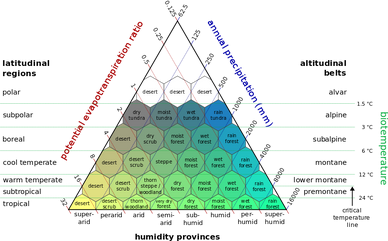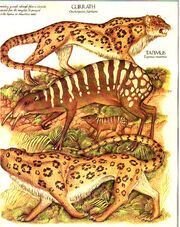Rainforests are a variety of biome that is known for heavy rainfall, warm temperatures, and high diversity of life. They are often evolutionary hotspots, and are most concentrated around the Equator.
Characteristics[]

Rainforests are along the far right side
Using the Holdridge life zones, a tropical rainforest is hotter than 24 °C and have an average annual rainfall of at least 800 cm. However, this is not the definition of rainforest, which is anything with a potential evapotranspiration ratio of less than .25 and an annual precipitation of more than 100 cm.
The division between different kinds of rainforest is mostly one of latitude, or biotemperature.[note 1]
Rainforests are amazingly diverse. Tropical rainforests alone house 50% of the life on the planet with only 2% of its space. A single bush in the Amazon can have more species of ants than all the British Isles.[1] They are also important in the field of medicine; 25% of Western medicines are derived from rainforest-dwelling organisms.[2]
Many animals that are representatives of older clades can be found in rainforests. Examples include velvet worms (or Onychophora), which took on a terrestrial existence around the Silurian period;[3] arowanas, which are a basal group from the lower Tertiary,[4] and the purple frog,[note 2] which is from the time of the dinosaurs.[5]
Tropical Rainforests[]

A map of the distribution of tropical rainforests
Found in Central America, South America, Madagascar, Oceania, Central and Western Africa, and Southeast Asia, tropical rainforests are divided into four layers: the emergent layer, the canopy, the understory, and the forest floor. They are the typical image conveyed by the term 'rainforest,' and are by far the most diverse. The above mentioned examples of living fossils are native to tropical rainforests.
Structure[]
Tropical rainforests have a clearly defined structure that greatly influences the evolution of lifeforms in the rainforest. These layers, from bottom to top, are the forest floor, understory, and canopy.
Forest Floor[]

The forest floor. Note that despite popular imagination, the forest floor is relatively open, permitting large animals to move about
The forest floor is the bottom layer, composed of dead, decaying matter, soil, and various decomposers, including many species of fungi that accelerate the decomposition of plant and animal matter. The air is virtually still, and only a fiftieth of the light from the top reaches to the forest floor.[6] It is populated by ground-dwelling organisms, such as ungulates; many species that can climb still spend vast periods of time on the forest floor, such as many species of amphibians, reptiles, and insects. Heavy rains dissolve nutrients in soil and leach them away. Nutrients are also absorbed very quickly, keeping them from entering the mineral soil and therefore from being leeched. The result is that soil quality in the rainforest is very poor.[7] Rather ironically, this means that tropical rainforest soil is some of the poorest, agriculturally speaking.[8]
The stereotypical 'jungle' is only present along the margins of rivers (which people originally traveled along, leading them to extrapolate that jungle was the typical condition)[9] or in disturbed areas.[10] Monsoon forests and mangroves also are referred to as jungles, as monsoon forests have more dense underbrush due to their more open canopies, often including lianas and numerous shrubs,[10] and mangrove forests have extensive prop-roots as well as very low canopies.
When designing animals that live in the forest floor, several things must be kept in mind:
- The forest floor is fairly dark. While it isn't pitch-black, it is dark enough that plants have a hard time growing; that's why the forest floor isn't completely impenetrable. Therefore, good low-light vision is fairly helpful. Exceptional hearing and smell may also be useful, and some sort of sonar, even poorly developed, could give a slight edge.
- Disruptive coloration among animals of the forest floor is very common, particularly among large mammals. Examples include the okapi, ocelot, jaguar, and leopard. The exact form varies; the okapi has stripes and the felines mentioned use spots. A significant association was found in Artiodactyla (even-toed ungulates) between the presence of either spots or stripes and dense forest habitat (stripes having a significant association with light forest habitat). Among carnivores, a significant association was found between having spots and living in dense habitats, such as rainforests, as well as the hunting of ungulate prey items.[11]
- Most cryptic coloration among forest floor-dwelling animals relies on making them look like dead forest debris. Often this means that they are brown, have ragged edges, and could be mistaken for dead leaves.
- Toxins are frequently present in animals that live in rainforests, whether they are amphibians, reptiles, insects, or even potentially (since this is speculative evolution) mammals. A familiarity with what poisonous or venomous animals usually use as warning colors and patterns--red, black, and yellow are the most effective and common[12] – are essential when designing such a creature, unless it is a predator that uses its venom to quickly disable a prey item after ambushing it.
Understory[]
The understory is several meters below the canopy, slightly above the forest floor, and holds small trees, shrubs, and tall herbaceous plants. Many popular houseplants, such as prayer plants and philodendrons, are native to this layer.
While the understory is still more crowded than the forest floor, it is much less crowded than the canopy. Bats, birds, and insects frequently fly over long distances in the understory, attracting predators.[13]
When designing organisms that live in the understory:
- Since the understory has more plant life, camouflage is more likely to be green than brown.
- Plants will often use ants as a defense, offering them food from extra-floral nectaries. When these nectaries are removed, herbivory increases. Plants will also protect ant colonies by forming structures called domatia, which include hollow thorns, steams, or expanded leaf bases. Some plants will even produce food for their ants. The result is that the plant has a very loyal defense force that will attack herbivores and interloping plants.[14]
- Plants that grow in low-light levels will divert resources from growing their root system into growing stems and leaves. This is one of the reasons why vines are so common in rainforests; they have few roots and divert many resources in the struggle to climb to greater heights.[15]
- Understory plants often have their flowers not hidden by leaves but prominently placed along the central stalk of the plant, sometimes even on the trunk in the case of trees.[13]
Canopy[]
The canopy is one of the largest areas in the rainforest (thirty to fifty meters off the ground) and has the highest biodiversity of all locations within the rainforest. As rainforests have the highest biodiversity of any terrestrial biome, tropical rainforest canopies are the most biodiverse terrestrial areas on the planet.[16]
In Speculative Evolution[]
Rainforests, mostly tropical ones, are often featured in speculative evolution, most likely due to the sheer range of possibility they offer. A biome so teeming in life is ripe for speciation into diverse forms. This can be seen even today, in creatures such as the (mostly) vegetarian spider and the flying lemur. Even assuming that unusual adaptations are no more frequent than in other areas, the sheer biodiversity means that there will still be more of them; many more.
In speculative evolution, tropical rainforests have housed creatures as diverse as spitfire birds to giant ground sloth-like kangaroos, and have been found everywhere from Antarctica (albeit far in the future) to Australia. The Future Is Wild particularly used rainforests, with two out of its twelve biomes featured being rainforests. Oceans tied, and the oceans featured in the 100 million year episode were shallow reefs, not the open ocean featured in the 200 million year episode.

A pair of gurraths
Like in real life, tropical rainforests are also refuges for descendents of clades that are all but extinct. In After Man: A Zoology of the Future, for instance, carnivorans can be found in tropical rainforests, where the gurrath and striger live.[note 3] Of these, neither can be considered anything close to a living fossil, though, since the striger has taken a completely different (and right criticized as evolutionarily ridiculous) path, and the gurrath has turned into a jaguar-like predator.
When working with geography not identical to ours, it is important to remember how rainforests form, and what is required for their formation. Usually, in worldbuilding, rainforests are placed on mountains which cause a rainshadow desert. However, this is not necessary for the existence of rainforests. For instance, there really aren't any mountains responsible for the existence of Amazonia. A mountain range isn't necessary to make an area rainy.
Notes[]
- ↑ The mean of all temperatures above freezing.
- ↑ Technically, the purple frog lives in montane forest. However, in common parlance, these fit under the term 'rainforest.' Furthermore, montane forest does not exist in the Holdridge life zones.
- ↑ The only other carnivore is a mustelid-like animal living in the north.
References[]
- ↑ Butler, Rhett. (2006, July 27). Retrieved from http://rainforests.mongabay.com/0301.htm.
- ↑ Evans, Michael. (2011, April 27). Rainforests. Retrieved from http://www.earthtimes.org/encyclopaedia/environmental-issues/rainforests/.
- ↑ Monge-Najera, J. (1995). "Phylogeny, Biogeography and Reproductive Trends in the Onychophora" (pdf). Zoological Journal of the Linnean Society 114 (1): 21–60. doi:10.1111/j.1096-3642.1995.tb00111.x.
- ↑ Allen, G. R.; Midgley, S. H.; Allen, M. (2002). Field Guide to the Freshwater Fishes of Australia. Perth: Western Australia Museum. pp. 56–58.
- ↑ Biju, S.D. and Bossuyt, F. 2003. New frog family from India reveals an ancient biogeographical link with the Seychelles. Nature: 711-714.
- ↑ Smithsonian Tropical Research Institute. (n.d.). Forest Floor. Retrieved from http://www.stri.si.edu/sites/rainforest/forest_floor.html.
- ↑ Marietta College. (n.d.). Tropical Rain Forest. Retrieved from http://www.marietta.edu/~biol/biomes/troprain.htm.
- ↑ WildMadagascar.org. (n.d.). Retrieved from http://www.wildmadagascar.org/overview/rainforests2.html.
- ↑ Baumann, Paul R. (2009). Tropical Wet Realms of Central Africa, Part 1. Retrieved from http://www.oneonta.edu/faculty/baumanpr/geosat2/Central%20Africa%20I/Central%20Africa%20Part%20I.htm.
- ↑ 10.0 10.1 Ritter, Michael E. (2012). Tropical Forests. In The Physical Environment: An Introduction to Physical Geography (Earth Biomes). Retrieved from http://earthonlinemedia.com/ebooks/tpe_3e/biomes/biomes_tropical_forests_page_1.html.
- ↑ Caro, Tim. (2005). The Adaptive Significance of Coloration in Mammals. BioScience, 55. Retrieved from http://wfcb.ucdavis.edu/people/faculty/timc/Caro2005.pdf.
- ↑ Stevens, Martin & Ruxton, Graeme D. (2012). Linking the evolution and form of warning coloration in nature. Proceedings of the Royal Society B: Biological Sciences, 279, 417–426.
- ↑ 13.0 13.1 Smithsonian Tropical Research Institute. (n.d.). Understory. Retrieved from http://www.stri.si.edu/sites/rainforest/understory.html.
- ↑ Stork, N. E. (1993, April). Tropical forest dynamics: the faunal components. In D.S. Edwards, W.E. Booth, S.C. Choy (Eds.), Tropical Rainforest Research — Current Issues. Paper presented at Conference on Tropical Rainforest Research — Current Issues, Bandar Seri Begawan, April (1-20). Netherlands, Springer.
- ↑ Noyd, Robert K. (2013). Biology: Organisms and adaptations. Stamford, CT: Cengage Learning.
- ↑ WWF. (n.d.). Tropical and Subtropical Moist Broadleaf Forest Ecoregions. Retrieved from http://wwf.panda.org/about_our_earth/ecoregions/about/habitat_types/selecting_terrestrial_ecoregions/habitat01.cfm.



